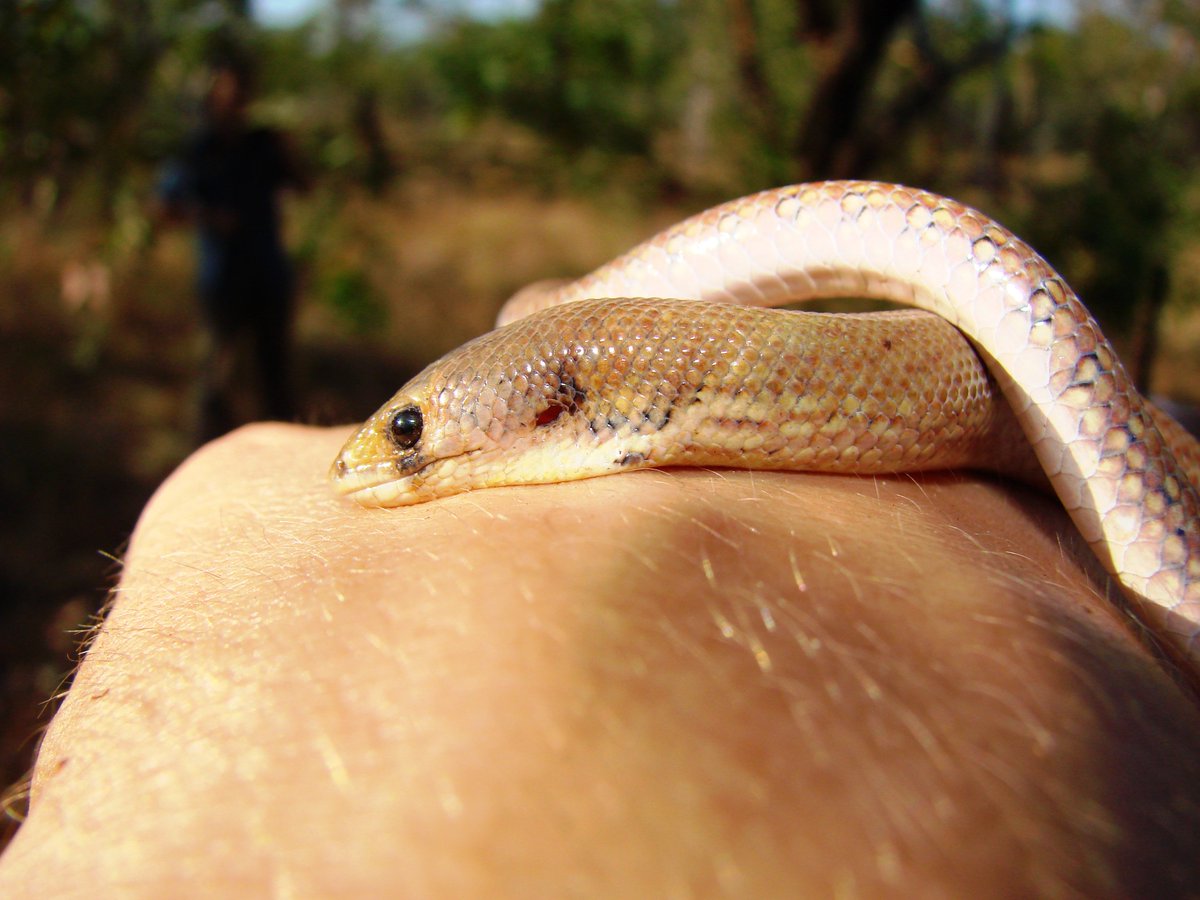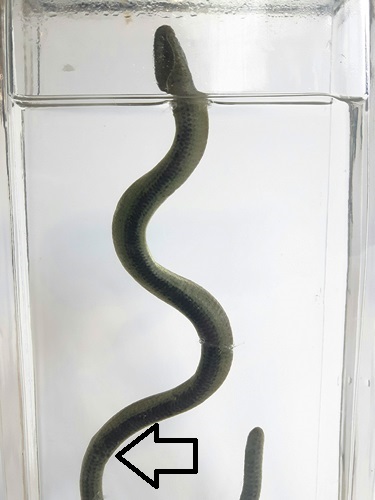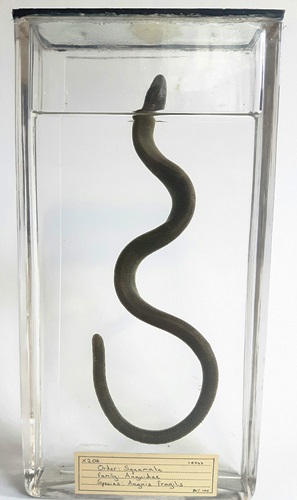What’s the difference between snakes and legless lizards? Specimen of the Week 248
By Jack Ashby, on 15 July 2016
Slow worms – They don’t have a leg to stand on
Not all legless reptiles are snakes, like this slow worm which is just one of the many kinds of legless lizards. The complete or near loss of limbs has evolved in lizards a great number of times. Some entire lizard families are legless. Some families contain a few species with tiny vestigial limbs, while the rest are limbless. Some families are mostly “normal” four-limbed species, with limblessness, near limblessness, or two-leggedness having evolved in certain lineages independently. The biggest lizard family – the skinks (of which there are 1500 of mostly leggy species) – has groups that have lost their limbs on numerous occassions in Africa, Europe and Australia. In most cases of legless lizards, some remnant of the hindlimbs is visible, often by the precence of scaly flaps.
Getting legless
Leglessness evolves when the legs become a hindrance rather than a help in an animals’ locomotion, and in lizards this is normally to do with burrowing. Essentially lizards have found that it is more effective to “swim” through the soil, pushing their way through little gaps with their heads. If you think about it, this makes sense because lizards’ arms aren’t that close to their snouts, so using them to dig can be a it awkward. This is one also one of the main hypotheses for how and why snakes evolved. Swimming is also a driving factor for losing limbs.
How do you tell a snake from a legless lizard?*
- Does it have ears holes?

A northern hooded scalyfoot (Pygopus schraderi) – an Australian legless lizard – with an obvious ear hole. (C) Jack Ashby
- Yes – it’s a lizard (even if they are slightly covered by flaps)
- No – it’s a snake.
- Does it have have eyelids?
- Yes – it’s a lizard.
- No – it’s a snake (probably). Snakes have a clear scale “spectacle” over their eyes.
- Does it have a fleshy tongue?
- Yes – it’s a lizard. (except monitor lizards, which have long thick forked tongues, and may be the group from which snakes evolved).
- No – it’s a snake. Snakes have long thin forked tongues.
- Does it have a long tail?

The arrow marks the position of the vent, a long way down the body – slow worms have short tails. You can also see the belly scales are small like the rest of the body, unlike snakes’ which are broad. LDUCZ-X206
This may sound like a stupid question – aren’t snakes all tail? The tail is the bit of the spine behind where an animal’s pelvis is, or would have been. This can also be determined by where the animal’s urogenitary opening is – the “vent” is a scale-covered slit through which reptiles do their excreting, defecating and reproducing.
- Yes – it’s a lizard. Lizards’ vents are a long way from the tip of their tails. But to complicate things many legless lizards can shed their tails as a predator-distraction trick, but the prescence of a regrowing, stumpy tail is also evidence that it’s not a snake.
- No – it’s a snake. Snakes’s vents are a long way from their heads (and snakes can’t drop their tails).
- Do the scales on its back look like the scales on it’s belly?
- Yes – it’s a lizard.
- No – it’s a snake. Snakes move by undulating elongated rectangular scales (or sometime pairs of scales) along their bellies, each one gripping and pushing against irregularities on the ground. They can’t move over teflon.
But snakes are legless lizards…
Just to end of a note of complication, snakes actually evolved from a group lizards (or from mosasaurs which probably themselves evolved from a group of lizards) – lizards are paraphyletic with respect to snakes as the group “lizard” by definition has to include snakes. So technically all snakes are legless lizards. However that isn’t regarded as a particularly useful way of looking at things, as all snakes are more closely related to each other than they are to legless lizards (snakes are monophyletic, with a single common ancestor). Legless lizards, on the other hand, are not all closely related to each other – they do not form a distinct taxonomic group (they are polyphyletic).
I should also mention two another long, thin legless reptile group – the amphisbaenians, which are also called “worm lizards”, and the dibamids. These are neither snakes nor “lizards”, but form seperate groups of their own. They wouldn’t be easy to confuse, unless you put them with blind snakes (a group of snakes which independently evolved to live underground), but that may be a story for another day.
*As with all things in the real world, not all of these characteristics apply to all lizards, but presence of one of them should be enough to tell you it’s not a snake.
Jack Ashby is Manager of the Grant Museum of Zoology
7 Responses to “What’s the difference between snakes and legless lizards? Specimen of the Week 248”
- 1
-
2
Snake Sightings | How to Prevent & Safely Remove Snakes wrote on 24 February 2017:

[…] on the head, their size, and color. If the creature you see has moveable eyelids, it’s probably a legless lizard since snakes only have a clear “spectacle” scale protecting their eyes. Some snakes do have […]
-
3
Handling and Health Checks – Myerscough with Alex wrote on 12 October 2018:

[…] the diffrence between snakes and legless lizards? Specimen of the week 248, https://blogs.ucl.ac.uk/museums/2016/07/15/whats-the-difference-between-snakes-and-legless-lizards/, Accessed […]
-
4
Photos from the field: Australia is full of lizards so I went bush to find out why – Non Perele – News Online wrote on 2 October 2020:

[…] above shows a Burton’s legless lizard (Lialis burtonis) — a predator of my study species. These snake-like reptiles are specialist lizard hunters and often use the dense cover of spinifex to their advantage to […]
-
5
Photos from the field: Australia is full of lizards so I went bush to find out why – MASSIVE.NEWS wrote on 3 October 2020:

[…] above shows a Burton’s legless lizard (Lialis burtonis) — a predator of my study species. These snake-like reptiles are specialist lizard hunters and often use the dense cover of spinifex to their advantage to […]
-
6
Australia is full of lizards so I went bush to find out why | Serenity Circle – Vocational Topics for Professionals wrote on 13 October 2020:

[…] a Burton’s legless lizard (Lialis burtonis) — a predator of my study species. These snake-like reptiles are specialist lizard hunters and often use the dense cover of spinifex to their advantage to […]
-
7
These lizards lost their legs but don t call them snakes | Glassview Farm wrote on 28 September 2023:

[…] https://blogs. ucl. ac. uk/museums/2016/07/15/whats-the-difference-between-snakes-and-legless-lizard… […]
 Close
Close



[…] guided by six experts in their field. We were divided up into groups of about ten, including Jack Ashby from the Grant Museum, and off we went up and down stairs, along labyrinthine corridors and […]